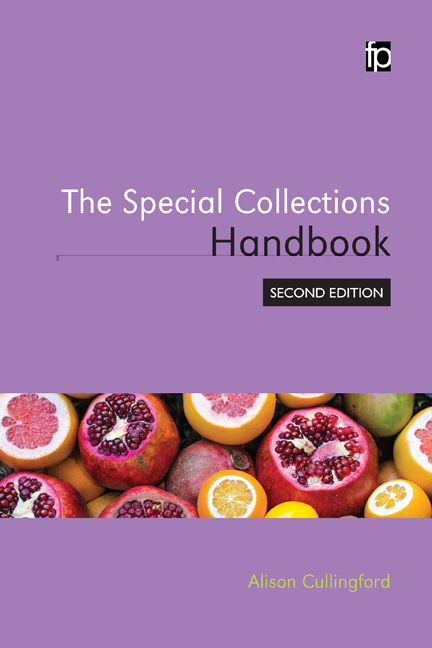Book contents
- Frontmatter
- Contents
- Preface and acknowledgements
- Introduction
- 1 The care of Special Collections
- 2 Emergency planning for Special Collections
- 3 Understanding objects in Special Collections
- 4 Acquiring and developing Special Collections
- 5 Cataloguing, description and metadata in Special Collections
- 6 Digitization and digital libraries in Special Collections
- 7 Legal and ethical issues in Special Collections
- 8 User services in Special Collections
- 9 Marketing and communications in Special Collections
- 10 Widening access to Special Collections
- 11 Organizational resources for Special Collections: space and people
- 12 Influencing and fund-raising for Special Collections
- Afterword: Special Collections futures
- Appendix A The Special Collections reference shelf
- Appendix B Skills for your Special Collections career
- Bibliography
- Index
9 - Marketing and communications in Special Collections
- Frontmatter
- Contents
- Preface and acknowledgements
- Introduction
- 1 The care of Special Collections
- 2 Emergency planning for Special Collections
- 3 Understanding objects in Special Collections
- 4 Acquiring and developing Special Collections
- 5 Cataloguing, description and metadata in Special Collections
- 6 Digitization and digital libraries in Special Collections
- 7 Legal and ethical issues in Special Collections
- 8 User services in Special Collections
- 9 Marketing and communications in Special Collections
- 10 Widening access to Special Collections
- 11 Organizational resources for Special Collections: space and people
- 12 Influencing and fund-raising for Special Collections
- Afterword: Special Collections futures
- Appendix A The Special Collections reference shelf
- Appendix B Skills for your Special Collections career
- Bibliography
- Index
Summary
Introduction
In this chapter we cover:
Marketing for Special Collections: an overview of the marketing mix.
Commodity/product and marketing themes.
Cost/price and convenience/place.
Communications/promotions, including key channels: websites, the press, exhibitions, social media and advertising.
Feedback and market research.
Other chapters relate to aspects of marketing Special Collections: metadata in Chapter 5, user services in Chapter 8, education and outreach in Chapter 10, and fund-raising and advocacy in Chapter 12.
Marketing in Special Collections and libraries is often equated with promotion (e.g. producing leaflets), but promotion is just one element of marketing. Marketing is about every interaction a library has with its users, defining and meeting their needs. All Special Collections librarians and other staff are involved in marketing, whether they realize this or not, and even if the organization employs marketing staff.
Librarians sometimes worry that marketing will lead to an increase in use: a concern if services can barely cope with existing levels of enquiries and visits. However, good quality communication by libraries means better informed Special Collections users who need less individual attention. Increased use can help librarians acquire funding and resources; diminishing use and hidden collections lead only to stagnation and threat.
The Special Collections marketing mix
A little marketing theory is helpful. The marketing mix covers all the elements that should be considered when discussing marketing. There are several variants: the 4Ps, the 4Cs, the 7Ps.
The traditional 4Ps (Product, Price, Place, Promotion) were introduced by McCarthy in the 1960s. For service industries, Booms and Bitner added three more Ps: People, Processes and Physical evidence. Potter (2012) shows how these seven apply to libraries. In this chapter, I follow Lauterborn's structure of the more user-oriented 4Cs (Commodity, Cost, Convenience, Communication).
Commodity: the Special Collections offer
Special Collections can offer users the following:
Collections. Libraries have little control over the collections they have inherited and acquiring appealing new material is not easy (as discussed in Chapter 4). However, the rich content of existing collections can be adapted and remixed to appeal to users; suggestions appear below.
- Type
- Chapter
- Information
- The Special Collections Handbook , pp. 169 - 192Publisher: FacetPrint publication year: 2016



